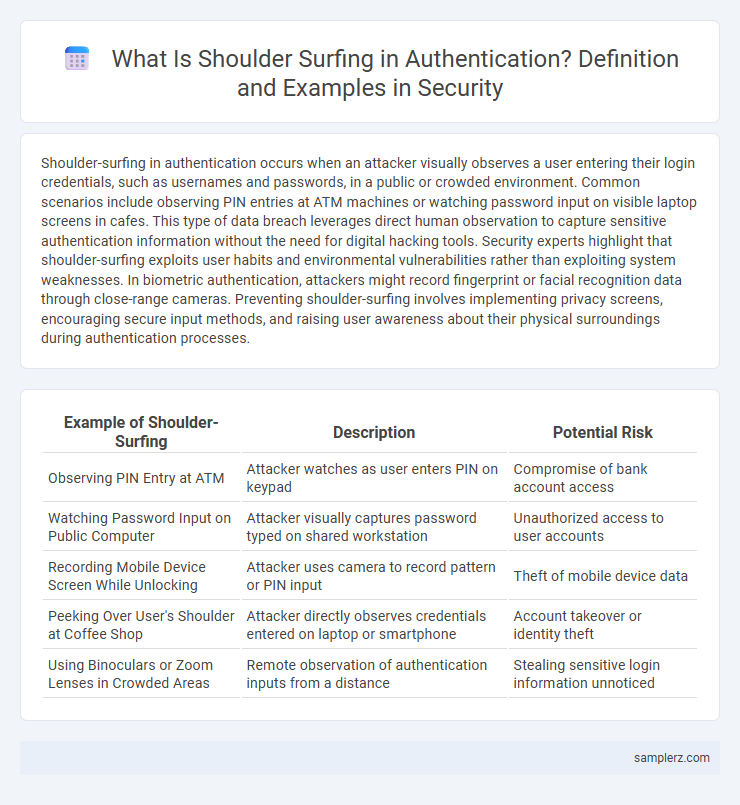Shoulder-surfing in authentication occurs when an attacker visually observes a user entering their login credentials, such as usernames and passwords, in a public or crowded environment. Common scenarios include observing PIN entries at ATM machines or watching password input on visible laptop screens in cafes. This type of data breach leverages direct human observation to capture sensitive authentication information without the need for digital hacking tools. Security experts highlight that shoulder-surfing exploits user habits and environmental vulnerabilities rather than exploiting system weaknesses. In biometric authentication, attackers might record fingerprint or facial recognition data through close-range cameras. Preventing shoulder-surfing involves implementing privacy screens, encouraging secure input methods, and raising user awareness about their physical surroundings during authentication processes.
Table of Comparison
| Example of Shoulder-Surfing | Description | Potential Risk |
|---|---|---|
| Observing PIN Entry at ATM | Attacker watches as user enters PIN on keypad | Compromise of bank account access |
| Watching Password Input on Public Computer | Attacker visually captures password typed on shared workstation | Unauthorized access to user accounts |
| Recording Mobile Device Screen While Unlocking | Attacker uses camera to record pattern or PIN input | Theft of mobile device data |
| Peeking Over User's Shoulder at Coffee Shop | Attacker directly observes credentials entered on laptop or smartphone | Account takeover or identity theft |
| Using Binoculars or Zoom Lenses in Crowded Areas | Remote observation of authentication inputs from a distance | Stealing sensitive login information unnoticed |
Common Real-World Examples of Shoulder-Surfing in Authentication
Common real-world examples of shoulder-surfing in authentication include public Wi-Fi hotspots where attackers observe PIN entries on smartphones or ATM keypads. Crowded environments like coffee shops and public transportation provide opportunities for malicious actors to visually capture usernames and passwords during login processes. ATM machines and point-of-sale terminals with poor privacy shields often expose sensitive authentication inputs to onlookers, increasing the risk of credential theft.
Shoulder-Surfing Attacks at ATMs and Payment Terminals
Shoulder-surfing attacks at ATMs and payment terminals involve criminals discreetly observing users entering PINs or passwords to gain unauthorized access to accounts. These attacks often exploit crowded or poorly designed environments where the keypad is visible to nearby individuals or hidden cameras. Implementing privacy shields, enhanced surveillance, and user awareness can significantly reduce the risk of credential theft in such scenarios.
Shoulder-Surfing During Mobile Device Unlocking
Shoulder-surfing during mobile device unlocking occurs when an attacker observes a user entering their PIN, password, or pattern lock in a public setting, compromising authentication security. Techniques such as discreet video recording or direct visual observation allow unauthorized access to sensitive information. Implementing biometric authentication methods and screen privacy filters can significantly reduce the risk of such shoulder-surfing attacks.
Public Computer Usage and Shoulder-Surfing Risks
Using public computers in libraries or internet cafes significantly increases the risk of shoulder-surfing, where attackers visually capture sensitive login credentials or PINs. These environments often lack privacy screens, making it easy for nearby individuals to observe authentication details during input. Implementing privacy screen filters and encouraging the use of virtual keyboards can help mitigate shoulder-surfing threats in public computer usage.
Password Entry Vulnerabilities in Cafés and Public Spaces
Shoulder-surfing during password entry in cafes and public spaces exploits the proximity of onlookers who visually capture login credentials, often unnoticed by the user. Public Wi-Fi environments exacerbate these vulnerabilities by combining observation risks with potential data interception, increasing the chances of unauthorized account access. Users should implement privacy screens, shield keypads, and remain aware of their surroundings to mitigate the risk of credential theft in such settings.
Biometric Authentication Exposed to Shoulder-Surfing
Biometric authentication methods such as fingerprint scans or facial recognition can be vulnerable to shoulder-surfing when an attacker observes the user during the authentication process. Techniques like high-resolution cameras or direct observation can capture biometric input, potentially leading to unauthorized access. Implementing privacy screens or using multifactor authentication helps mitigate the risks associated with biometric shoulder-surfing attacks.
Social Engineering and Shoulder-Surfing Combined Attacks
Social engineering techniques often exploit shoulder-surfing by manipulating victims into revealing sensitive authentication details while an attacker visually captures the input, such as PINs or passwords, in public spaces. This combined attack increases the risk of unauthorized access as attackers gather information through both psychological manipulation and physical observation. Effective security measures include privacy screens, awareness training, and multi-factor authentication to mitigate the risks posed by these intertwined threats.
Shoulder-Surfing in the Workplace: Internal Threats
Shoulder-surfing in the workplace poses significant internal security threats as employees or insiders visually capture sensitive authentication information such as passwords or PINs. This practice often occurs near shared workstations, conference rooms, or open office layouts where unauthorized personnel can easily observe login credentials. Implementing privacy screens, secure authentication methods, and employee awareness training effectively mitigates the risks associated with internal shoulder-surfing attacks.
Visual Hacking in Educational Institutions
Shoulder-surfing in educational institutions often occurs when students or unauthorized individuals observe login credentials being entered on shared devices or public terminals, leading to visual hacking. This form of attack exploits the lack of privacy in crowded environments such as computer labs and libraries, where passwords and authentication codes can be easily captured. Implementing privacy screens, strict access controls, and user awareness training significantly reduces the risk of visual hacking in academic settings.
Case Studies: High-Profile Shoulder-Surfing Incidents
High-profile shoulder-surfing incidents include the 2016 Olympic Games, where attackers discreetly recorded athletes entering PINs at payment terminals, compromising financial security. Another example occurred in a major financial institution in 2019, where employees captured passwords by observing colleagues during login, leading to significant data breaches. These cases highlight the vulnerability of authentication methods reliant on visible input, emphasizing the need for secure, covert authentication technologies.

example of shoulder-surfing in authentication Infographic
 samplerz.com
samplerz.com